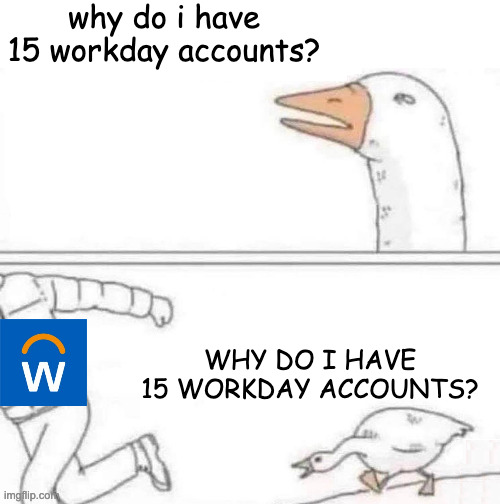Unemployed, Take 2: What Happens When You Go Viral on LinkedIn
04 Apr 2024
Well, it happened again. I once again went viral on LinkedIn, this time for making a meme about Workday.

This obviously makes me an expert in this subject, so I feel compelled to write a blog about it. Did your post recently go viral on LinkedIn? Here’s what to expect.
Goodbye, notifications
LinkedIn notifications are weird. There are many different types of notifications, and it is hard to know at a glance which ones are enabled, which are not, and which settings are related to the notifications you are getting at this moment. If you have post go viral on LinkedIn, the type of notifications you may start receiving on your phone, on the LinkedIn website, and through your email may include:
- Connection request notifications from people who have seen your post and want to now connect with you on LinkedIn for various reasons.
- Notifications about who has viewed your profile.
- Notifications about who has followed you.
- Message requests from people messaging you about a hashtag you used.
- Message requests from LinkedIn Premium members.
- Message notifications from LinkedIn members you’re connected to.
- Message requests from random people if you have LinkedIn Premium and set your profile to “open”
- Post reaction notifications
- Post comment notifications
- Notifications about reactions to people’s comments on your post
- Notifications about replies to comments on your post
- Reshare notifications
It can be a lot. Alternatively, if you disabled a bunch of these notification types some time in the past, you may see your post doing numbers and wonder why you’re not getting any notifications about it. In either case, should you want to adjust your notification settings, the place to do so is Me -> Settings & Privacy -> Notifications. From there you can dive into the different categories of notifications and decide which ones you want to enable and disable. For viral posts, most of what you’ll want to fiddle with will be located in the Posting and commenting section.
Hello, randos
The other big thing you will notice once your LinkedIn post goes viral is just how many “HR consultants” and resume writers there are on the network and just how eagerly they all want to talk to you. I’ve noticed this is particularly the case if your post has the #OpenToWork hashtag. It’s like a magnet for parasites that prey on job seekers. The messages they send all tend to follow a similar format. The first message tends to be fairly innocous, thanking you for connecting and asking how you are. Or it talks about how they are surprised that someone with your qualifications is currently on the job market. Should you engage with this first message, they then ask what position you’re seeking. After that, they ask for your resume. Should you send them your resume, they will “take some time to review it” and then write back with vague recommendations to tailor your resume for an ATS and reword it to highlight your accomplishments. And that when the pitch happens: For a small fee, they can rewrite your resume in a way that will “surely stand out and win you interviews.”
The profiles that send these messages may have names that don’t match the pictures. (A brunette white lady named “John,” for example.) Of course, names have no gender and you should never assume someone’s pronouns. But in these cases, its very clear that the profiles were created by lot with the intention of easily throwing them away. They tend to have little to no activity, shallow experience sections, and implausible educations. (Why is this University of Michigan grad living in Nigeria?)
Why do these fake people want your resume? What would you actually get in return if you gave them money? Should I expect that my identity will be stolen soon?
Probably data-mining, nothing that will actually help you get a job, and yep. To be a job seeker is to voluntarily give your name, email address, phone number, and experience info to recruiters, applicant tracking systems, and other random people who you hope may be able to get you a job. It requires vulnerability that leaves you open to predatory people who are all too happy to make a buck off of someone who is already at their lowest. Do your best to use your criticial thinking skills when interacting with strangers. But if you do get swindled, know that it’s not your fault for taking a risk on someone.
Genuine connections
It’s important to note that there are some truly good things that can come out of your LinkedIn post going viral. I have made some genuine new connections with other job seekers as well as real recruiters and hiring managers. I’ve connected with other people who have shared their stories in my comments and expressed their support for my struggles. If you can filter through the noise of notifications and fake profiles, you can find an encouraging community of workers trying to thrive amidst our capitalist hellscape of a civilization. Take the time to acknowledge them, build those relationships, and explore the opportunities this moment provides you.
And once you’ve gotten your notifications under control and the scammers have scurried back into the shadows, consider starting a blog. ;-) After all, why should LinkedIn own all your brilliant prose?
